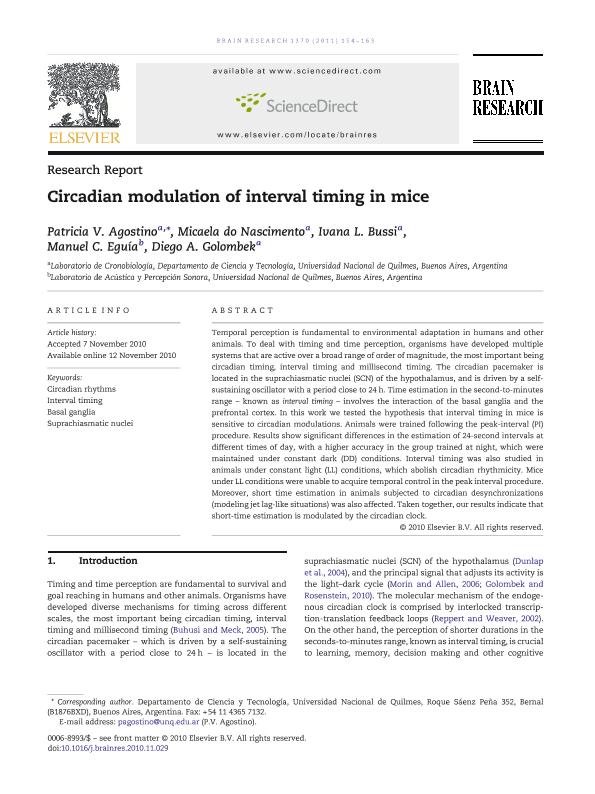Artículo
Circadian modulation of interval timing in mice
Agostino, Patricia ; Do Nascimento, Micaela
; Do Nascimento, Micaela ; Bussi, Ivana Leda
; Bussi, Ivana Leda ; Eguia, Manuel Camilo
; Eguia, Manuel Camilo ; Golombek, Diego Andres
; Golombek, Diego Andres
 ; Do Nascimento, Micaela
; Do Nascimento, Micaela ; Bussi, Ivana Leda
; Bussi, Ivana Leda ; Eguia, Manuel Camilo
; Eguia, Manuel Camilo ; Golombek, Diego Andres
; Golombek, Diego Andres
Fecha de publicación:
10/2011
Editorial:
Elsevier Science
Revista:
Brain Research
ISSN:
0006-8993
Idioma:
Inglés
Tipo de recurso:
Artículo publicado
Clasificación temática:
Resumen
Temporal perception is fundamental to environmental adaptation in humans and other animals. To deal with timing and time perception, organisms have developed multiple systems that are active over a broad range of order of magnitude, the most important being circadian timing, interval timing and millisecond timing. The circadian pacemaker is located in the suprachiasmatic nuclei (SCN) of the hypothalamus, and is driven by a self-sustaining oscillator with a period close to 24 h. Time estimation in the second-to-minutes range - known as interval timing - involves the interaction of the basal ganglia and the prefrontal cortex. In this work we tested the hypothesis that interval timing in mice is sensitive to circadian modulations. Animals were trained following the peak-interval (PI) procedure. Results show significant differences in the estimation of 24-second intervals at different times of day, with a higher accuracy in the group trained at night, which were maintained under constant dark (DD) conditions. Interval timing was also studied in animals under constant light (LL) conditions, which abolish circadian rhythmicity. Mice under LL conditions were unable to acquire temporal control in the peak interval procedure. Moreover, short time estimation in animals subjected to circadian desynchronizations (modeling jet lag-like situations) was also affected. Taken together, our results indicate that short-time estimation is modulated by the circadian clock.
Palabras clave:
BASAL GANGLIA
,
CIRCADIAN RHYTHMS
,
INTERVAL TIMING
,
SUPRACHIASMATIC NUCLEI
Archivos asociados
Licencia
Identificadores
Colecciones
Articulos(SEDE CENTRAL)
Articulos de SEDE CENTRAL
Articulos de SEDE CENTRAL
Citación
Agostino, Patricia; Do Nascimento, Micaela; Bussi, Ivana Leda; Eguia, Manuel Camilo; Golombek, Diego Andres; Circadian modulation of interval timing in mice; Elsevier Science; Brain Research; 1370; 10-2011; 154-163
Compartir
Altmétricas



